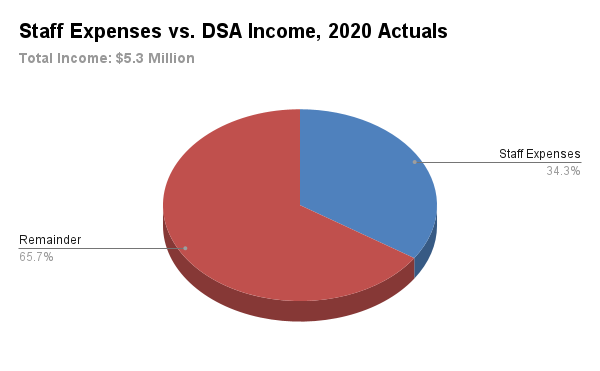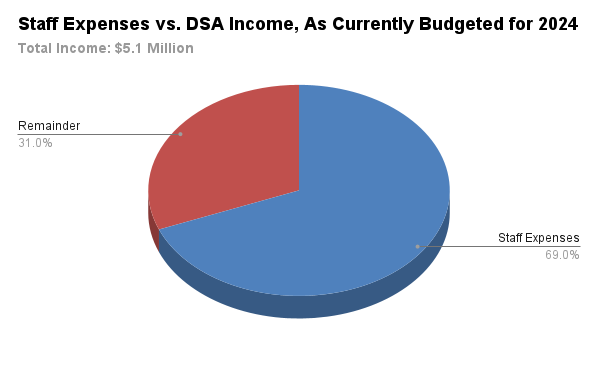How Red Star Is Thinking About Layoffs
Prepared by the Red Star Cabinet
Why is Red Star proposing layoffs?
Based on the Treasurer’s reports, DSA National will become insolvent by the end of the calendar year 2024. Laying off staff is the only path to solving this budget crisis –more than 2/3 of DSA National’s income goes to staff costs – and the sooner we initiate the process, the more staff jobs we can save. We respect the collective bargaining agreement (CBA) as the foundation for our relationship with DSA’s staff union, and the process outlined in the CBA specifies a 45 day timer between formal notice of layoffs and the execution of those layoffs, allowing time for the union to make a counter-proposal to hit the budget targets. If we end up having to dig deeper into our reserves, that will make the potential next wave of cuts even worse, with more staff laid off than we would lay off if we did them now and preserve our reserve funding.
Our philosophy here is to cut deep and cut once: the org needs to make layoffs, and in our view, the goal is to do so to a level that secures DSA National’s continued solvency through this NPC term and at least 6 months into the next one. This is why Red Star proposed and the NPC passed a target of maintaining sufficient cash reserves through December 2025.
The layoffs come after a lengthy and arduous process where the Budget & Finance Committee and NPC have already cut over $900,000 in spending from what was spent in 2023. This includes a hiring freeze and deep cuts to organizing projects.
Why is Red Star not proposing to hit a target deficit?
DSA’s budget problems are not simply reducible to ending overspending on various projects; our budget has fixed recurring costs – largely staff-related, but also some tech tools – that we carry from year to year. Further, when we lay off staff, we actually add one-time costs onto the books: severance, job placement assistance, etc. However, the long-term effects of layoffs give us better stability moving forward because we are reducing the fixed costs of running DSA. Since staff gets paid on a continual basis, if we don’t reduce staff numbers now, we will have to cut more deeply and destructively in the future. We recognize that this is a demoralizing experience for everyone in DSA, and that’s why we’re aiming for a one-time layoff proposal that will stabilize us through 2025 and beyond.
How did we get here?
We began to hire a significant number of new staff (increasing headcount by about 60%) after the 2020 Bernie bump when a huge influx of members – and therefore dues revenue – ballooned our forward-looking financial expectations. Additionally, we saved over $500,000 in 2021 by having a virtual convention instead of in-person. Because we’re 100% member-funded, by nature we have very little foresight into how our revenues are going to change, up or down. It makes sense to hire more people in an upswing in preparation for more growth, but when that 2020 growth turned into a slump and then a decrease in members over the next 4 years, we didn’t move proactively to decrease our spending levels in accordance with the deficit we were running at that point.
Let’s be clear: the financial opacity that has pervaded our National organization during the previous NPC term was a leadership failure, but it is not solely attributable to any one group. When they made these hires, the previous NPC were making reasonable decisions based on information they had available in 2020 and based on the current model of DSA as a member-governed nonprofit that primarily leverages staff to grow its operations. However, due to a general collapse of trust and governance ability in the previous NPC, the right interventions to course correct were never made — that’s why we’re in this dire situation today. We’re course-correcting to get headcount in line with where we were before the 2020 hiring wave, because our membership – and therefore revenue – numbers are approximately at the same level as they were pre-2020. We thus view this intervention as right-sizing our staff for the org we are today.
It’s important to note – since we’re going into an election year and we may see another bump in member dues in 2024 – that Red Star wants to see members contributing the bulk of labor to scale up our operations, rather than growing staff costs, and thus move away from the member-governed nonprofit model (more on that topic below).


Why not cut dues share?
Chapters are where DSA has the most member engagement and where the actual socialist development is done. Cutting dues share would effectively permanently sever ties between chapters and National. If dues share were cut, chapters would have to do local dues drives, further distancing themselves from the DSA network and infrastructure. We want a healthy network of chapters that are all invested in the success of National; without dues share, chapters would be competing against National and each other for desperately needed funding, and the social effect would be catastrophically disorganizing. By continuing to send funds out to chapters, we are supporting their recruitment, bringing in more members which provide more dues which are the only source of revenue for DSA.
Beyond the financial risks, we don’t support dues cuts as a political red line; it would fundamentally change the character of DSA in a counter-revolutionary way. We believe that chapters are the lifeblood of DSA, and we are staunchly against any cuts to dues share, period.
That said, if larger, financially-stable chapters want to voluntarily return some of their dues shares to national as a sign of investment in the National infrastructure, we welcome this. The sooner we can stabilize the budget, the sooner we can take aim at programmatic drives meant to grow the organization again – in a measured way so as to preclude this happening again.
What are we going to do about all the work that used to be done by staff?
We recognize that a lot of work may not get done in the short term; there’s no way around that. We aim to craft a layoff plan that protects DSA’s core functions, but things will inevitably fall through the cracks. The whole NPC needs to enact a key vibe-shift to make this transition possible: we need to empower members to work with the remaining staff to make them more efficient and effective. This means enacting changes such as including the National Technology Committee in technology work, letting rank & file members contribute to the Communications Committee, and leaning more on the Growth and Development Committee to grow and develop our membership.
We want to see DSA become a primarily member-run party – not just member-governed nonprofit – and to get there, we must empower members to work with staff. We believe that social practice is the best way to develop socialist organizers. Engaging members in the project of running the national organization is a key component of the democratization of DSA and a milestone on the way to becoming a truly democratic socialist party.

